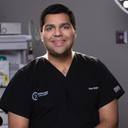Posted underLower Facelift q&a
Concerned about scarring in front of sideburn, but I don't want to have my sideburn pulled back either. Lower Facelift Advice?
I saw 3 board certified surgeons, two recommended lower face lift. One does lift in front of sideburn to avoid hair loss, and the other in the scalp for the same reason. I'm concerned about scarring in front of sideburn, but I don't want to have my sideburn pulled back either. I wear my hair off my face. Neck would improve with first, second suggested lift under the chin, a scar about an inch long. Second and third both recommended fat transfer to cheek/eyes area; two recommended lower Blepharoplasty. Third doctor ruled out other reasons. I'm now confused. Any advice?
Answers (22)
From board-certified doctors and trusted medical professionals
Dr. Brent Moelleken, MD

Dr. Brent Moelleken, MD
Beverly Hills Plastic Surgeon
Answer
Dr. Mike Majmundar, MD

Dr. Mike Majmundar, MD
Board Certified Facial Plastic Surgeon
Answer
Dr. Jed H. Horowitz, MD, FACS

Dr. Jed H. Horowitz, MD, FACS
Board Certified Plastic Surgeon
Answer
Dr. Larry S. Nichter, MD, MS, FACS

Dr. Larry S. Nichter, MD, MS, FACS
Board Certified Plastic Surgeon
Answer
Dr. Thomas T. Le, MD

Dr. Thomas T. Le, MD
Board Certified Facial Plastic Surgeon
Answer
Dr. Thomas Buonassisi, MD

Dr. Thomas Buonassisi, MD
Board Certified Facial Plastic Surgeon
Answer
Dr. Stephen Prendiville, MD

Dr. Stephen Prendiville, MD
Board Certified Facial Plastic Surgeon
Answer
Dr. Frank P. Fechner, MD

Dr. Frank P. Fechner, MD
Board Certified Facial Plastic Surgeon
Answer
Dr. William Portuese, MD
Dr. William Portuese, MD
Board Certified Facial Plastic Surgeon
Answer
Dr. Todd Christopher Hobgood, MD
Dr. Todd Christopher Hobgood, MD
Board Certified Facial Plastic Surgeon
Answer
More Lower Facelift Questions
See all Lower Facelift Q&AWE SEND PRETTY
EMAILS
What’s trending? Who’s turning heads? Which TikTok myths need busting? We’ve got you. No fluff, no gatekeeping—just real talk. Get our free, unfiltered newsletter.